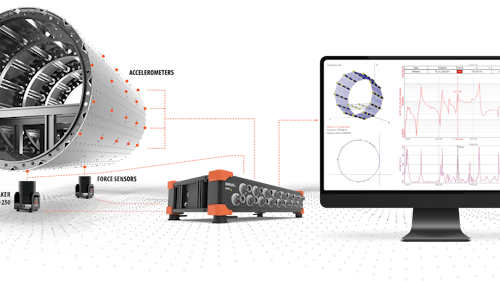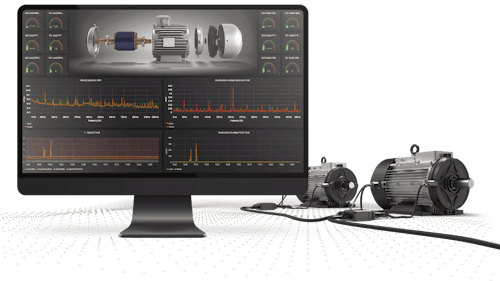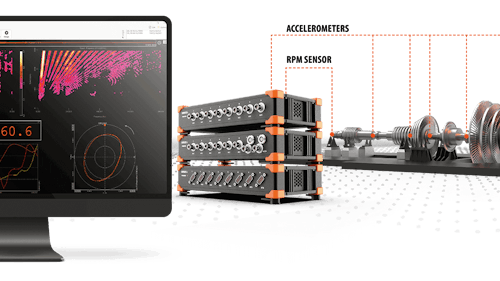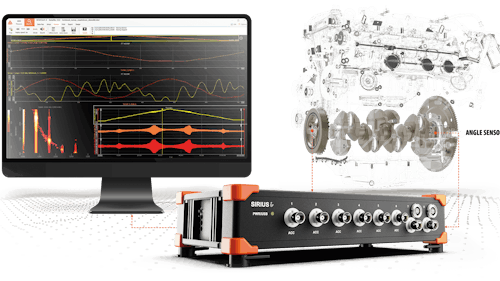NEMOSENSE
Low-noise vibration data logger and IoT device
Dewesoft data acquisition systems are used on offshore wind turbines for online wind turbine condition monitoring and wind turbine structural health monitoring with the aim to achieve the reduction of the cost of wind energy and optimize ROI.
The condition monitoring system provides distributed high-channel-count and remote monitoring. We provide a turn-key solution from DAQ systems, and data loggers, to sensors together with Windows-based data processing and high-level cloud-based monitoring software.
Dewesoft condition monitoring system is a complete solution including highly accurate signal conditioning systems, data acquisition and processing software, sensors, and accessories that are used in structural health and condition monitoring of wind turbine towers.
Dewesoft DAQ devices are designed to be distributed under any condition. EtherCAT technology allows devices to be placed near the sensors and connected with a single cable for power, data, and synchronization. The cable can span up to 100m between DAQ nodes or virtually unlimited using EtherCAT to fiber optic converters.
Input amplifiers offer support for any strain gauge, low-frequency accelerometer, temperature, weather, wind power, and wind turbine performance monitoring sensors.
All data channels are synchronized well below microsecond accuracy, required for deep structural analysis.
With dynamic ranges up to 160dB, our customers are claiming they can see fish hitting the structure.
From extremely rugged IP67 units with very high dynamic range to cost-effective solutions offer a tailored approach for virtually any structure with the possibility to monitor and analyze thousands of data points.
DewesoftX software offers real-time diagnosis, pre-processing, and data reduction with powerful math. A wide variety of storage options are possible with powerful visualization choices.
Use recorded time data to estimate modal models. With OMA the dynamics of the structural vibrations can be determined directly from the sensor input data via the Dewesoft ARTeMIS OMA software.
Using DewesoftX, data is available in a wide variety of formats, from exported data to live OPC UA interface or modern cloud data services.
The entire system can be remotely operated offering triggered storing, alarms, and other monitoring features with capabilities to store data locally or at distant remote locations.
Every Dewesoft data acquisition system is bundled with award-winning DewesoftX data acquisition software. The software is easy to use but very rich and deep in functionality. All software updates are free forever with no hidden licensing or yearly maintenance fees.
Enjoy our industry-leading 7-year warranty. Our data acquisition systems are made in Europe, utilizing only the highest build quality standards. We offer free and customer-focused technical support. Your investment into the Dewesoft solutions is protected for years ahead.
And we're confident you'll love it too! But don't just take our word for it. Get hands-on with a demo unit, completely free of charge. No strings attached, just real data. Reach out to your local Dewesoft team and get your demo unit now!
It includes everything you need for advanced data acquisition and common signal processing — no maintenance fees, no contracts. You buy it, you own it. All future updates? Free forever. And the best part? Analysis seats are unlimited and free. Once the data is recorded, anyone can download our software to review and analyze your data — no license needed.
Dewesoft is 100% owned by employees who believe in what we do — and love doing it. We’re in this with heart, passion, and long-term commitment. What does that mean for you? Our core value — caring for our customers — isn’t going anywhere. We’re here for the next 100 years, protected from outside acquisitions. Your investment in our technology is safe, supported, and future-proof.
At Dewesoft, quality isn't just a promise — it's a core value. Our products are 100% designed, developed, and manufactured in-house, right in the heart of the European Union. From precision machining and PCB manufacturing to final assembly and software development — we do it all ourselves, to the highest ISO standards. We're proud to support local production and take social responsibility seriously.
At Dewesoft, quality is more than just a word — it's a commitment. That's why our products come with an industry-leading 7-year warranty. It's just one more way we protect your investment and give you peace of mind for the long run.
Wind turbine condition monitoring is aimed at detecting changes in wind turbine behavior as early as possible. The main goal is to predict developing faults in order to minimize performance degradation and economic cost. It is performed by constant monitoring of specific parameters and comparing them to parameters obtained during “normal” operational behavior.
Condition Monitoring is focused on monitoring wind turbine drivetrain components. Dewesoft offers condition monitoring solutions for any kind of rotating machinery like shafts, bearings, gearboxes, and generators.
The most commonly used sensors for Wind Turbine Condition monitoring are:
Accelerometers to detect bearing faults, and gear tooth failures.
Temperature sensors to detect overheating.
Pressure sensors.
Rotational speed sensors - to perform order tracking analysis in variable speed wind turbines.
Current clamps to measure current signals for identification of faults in generators.
Oil-based sensors - to detect water content, debris, particle concentration.
More details ond Dewesoft condition monitoring solution.
Condition Monitoring in the case of structural components, like foundations, blades, and towers, is termed Structural Health Monitoring. Failures of Wind Turbine Structural components can significantly affect the wind turbine operational costs and in some cases can result in a complete loss of the turbine (tower collapse).
Offshore wind turbines are particularly exposed to harsh environments (wind, wave load, stress, corrosion) and higher risk. Therefore it is essential to perform monitoring of the structural components to reduce maintenance costs and avoid catastrophic failures.
The most common sensors for Wind Turbine Structural Health Monitoring are:
Accelerometers to perform OMA (Operational Modal Analysis).
Strain gauges to verify design assumptions under applied loads
Temperature sensors - especially in combination with strain gauges for temperature compensation.
Inclinometers to monitor the stability of the tower.
Anemometers - to monitor wind speed and direction.
Wave radars - to monitor wave height.
Dewesoft can offer a complete SHM solution for monitoring all the necessary parameters (vibration, strain, inclination, temperature measurements) needed to assess the condition of wind turbine structural components.
Wind turbine vibration monitoring is the most commonly used technique in Wind Turbine condition monitoring due to the fact that most damages in rotating machinery are reflected as higher vibration levels at frequencies specific to a developing fault.
In the case of Structural Health Monitoring vibration data is collected to perform the Operational Modal Analysis technique in order to detect developing faults. Changes in geometric and stiffness properties are reflected as changes in modal properties like modal shapes, damping ratios, and natural frequencies.
Dewesoft offers state-of-the-art 3-axial accelerometers with integrated data acquisition (IOLITEicw-3xMEMS-ACC) specifically designed for vibration monitoring of structures. DewesoftX data processing software offers a wide range of vibration math capabilities. Export options are available to facilitate the performance of Operational Modal Analysis and assessment of structural health.
Acceleration and inclination measurement: Dewesoft IOLITEicw-3xMEMS-ACC-INC is a triaxial MEMS accelerometer and static inclinometer with an EtherCAT interface. Offers 8 g measurement range for wind turbine vibration analysis.
Cabinets: Dewesoft can provide custom-made cabinets with all instrumentation preinstalled.
Industrial PC: We can provide our own or 3rd party industrial computers, This will run our DewesoftX software for acquisition of the installed sensors. Power Supply and UPS are available as well.
Cables: A single CAT6 cable is used for daisy-chaining the EtherCAT devices. We offer inexpensive to high-end robust cables (UV resistant, Oil resistant, Ozone resistant, Water and humidity resistant, Shielded, Flame retardant, Low emission of smoke and other acidic gases, halogen-free), as well as off-shore certified (MUD-resistant following NEK 606) cables.
Mounting brackets: Custom-made mounting brackets and other accessories can be provided by Dewesoft.
Other accessories: Cable tear protection can be provided to prevent bending or squishing of the cable. Cable clamps (also with magnets) to fix cables on towers where cable trays are not available can be provided upon request.
The Dewesoft monitoring system is based on distributed data acquisition devices with an EtherCAT interface. DAQ devices are daisy-chained using a single cable for data communication, power, and synchronization. The devices act as EtherCAT slave devices whereas the PC running the DewesoftX software acts as an EtherCAT master.
Raw data from DAQ devices are collected and processed by measurement units running the DewesoftX data acquisition software. It provides a wide range of configurable triggered recording and math capabilities. Data can be sent over the TCP/IP network to the factory or cloud server in batch files or streamed via OPC UA protocol.
Data can be accessed, viewed, and analyzed on the client PC or stored in the time series database (Historian) and served to SCADA systems or Cloud Software using standard interfaces such as OPC/UA, XCP, or Rest API. It is truly an Industry 4.0-ready architecture.
EtherCAT devices on the same tower are synchronized over the EtherCAT chain which offers the synchronization down to 1 us. EtherCAT devices between different towers are synchronized to the local NTP server. The synchronization between them depends on the latency of the network but is expected to be within 10 ms. If better synchronization is required we also offer a GPS synchronization option.
Dewesoft provides very rugged data acquisition systems that can work flawlessly in a wide temperature range (-40°C .. +85°C), under big stress, and even in very humid and wet environments. Our rugged systems provide IP67 environmental protection and 100 G shock protection.
The devices can easily be distributed so you can place them close to the sensor placed on the structure. This means shorter sensor cabling which increases signal quality and decreases the chances of cabling errors and cabling cost. DAQ systems can be distributed down to a single channel.
EtherCAT protocol provides easy distribution of devices over large structures. Devices can span up to 100 meters from node to node. Single power is used for data, power, and synchronization. This can be further expanded using EtherCAT to Fiber Optic converters.
DewesoftX software offers easy and flexible configurations for your data flow. You can store data locally near the structure itself, or use any of the standard interfaces like OPC UA to send and store data remotely in the cloud or database. There is really no restriction on how to set up your data flow.
Our flexible licensing allows you to connect an unlimited number of desktop or web-based view clients to monitor data in real-time without any additional cost.
The Historian software package provides a time-series database for long-term data storage. The database can be either located locally, on the remote server, or in the cloud. The solution is based on the InfluxDB time-series database open source project.
Historian provides several useful features for your historic data:
Raw and reduced data: while raw data is always stored on the measurement unit for an in-depth analysis, a Historian takes the role of long-term reduced data storage in the cloud database.
Data safety and retransmit: if the connection between the measurement hardware and the database is lost, the data is safely stored locally on the measurement unit and then retransmitted to the database when the connection is available.
Trending and Analysis: Historical data can always be recalled and loaded from the Historian database and used for trend analysis as well as for in-depth analysis and root cause identification.
Wind turbines are constantly exposed to wind forces, structural vibrations, and environmental conditions that can impact their long-term stability. Dewesoft Operational Modal Analysis (OMA) provides a simple, cost-effective way to assess the structural integrity of wind turbine towers under real operating conditions—without the need for artificial test excitations.
With Dewesoft ARTeMIS OMA software, you can extract critical modal parameters, including natural frequencies, damping ratios, and mode shapes, using only response data. Unlike traditional ODS (Operating Deflection Shape) analysis, OMA eliminates external noise influences and provides unbiased modal insights, allowing for precise condition monitoring and early detection of potential structural issues.
Designed for affordability and ease of setup, Dewesoft’s OMA solution seamlessly integrates with Dewesoft DAQ systems. Simply acquire operational vibration data, open the DXD files directly in ARTeMIS OMA, and run the analysis—ensuring fast, reliable results to optimize wind turbine performance and prevent costly failures.
Learn more: Modal testing and modal analysis solution page.
You can read more details about wind turbine tower monitoring in our case study.
Many offshore wind turbine farm managers have installed measurement technology for continuous structural health monitoring on the towers. Various sensing techniques and methods are used for performing structural health monitoring. The most widely used is the vibration-based technique, also known as Operational Modal Analysis (OMA).
Read the Offshore Wind Turbine Tower Monitoring case study.
See and browse related and compatible data acquisition products.
Low-noise vibration data logger and IoT device
Modular Industrial Data Acquisition (DAQ) Systems
Low-Noise Triaxial MEMS Accelerometers and Inclinometers
Small, Rugged, IP67 Datalogger and Processing Computer
Rugged EtherCAT Data Acquisition (DAQ) System
Time-Series Database for Long-Term and Permanent Monitoring Applications
Award-Winning Data Acquisition and Digital Signal Processing Software
See and browse related and compatible testing solutions.

Structural dynamics testing and analysis solution

Vibration monitoring for gearboxes, fans, motors, pumps, etc.

Noise and vibration analysis for rotating and reciprocating machinery

Measure angular vibration of the rotating shafts